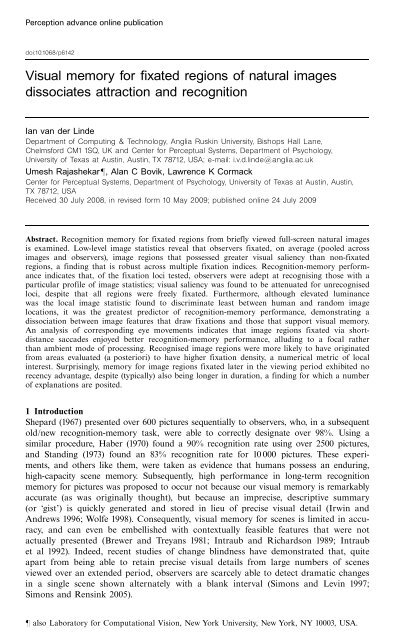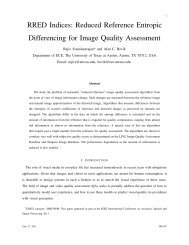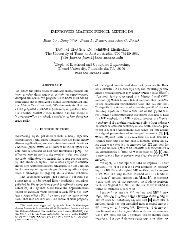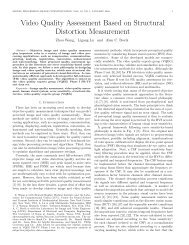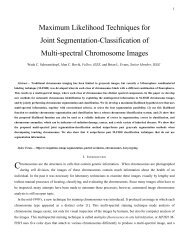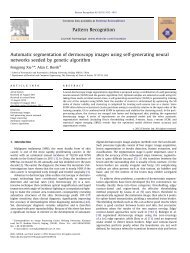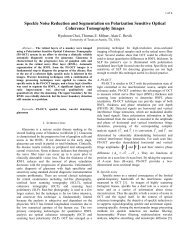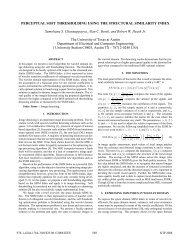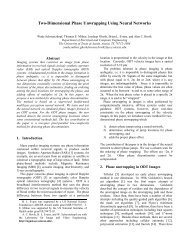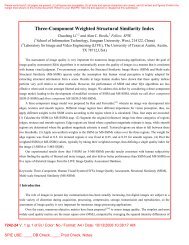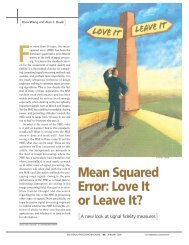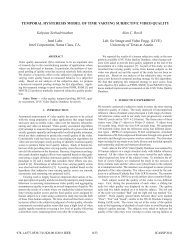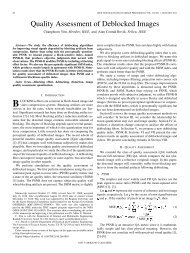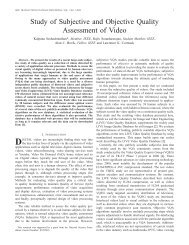Visual memory for fixated regions of natural images dissociates ...
Visual memory for fixated regions of natural images dissociates ...
Visual memory for fixated regions of natural images dissociates ...
You also want an ePaper? Increase the reach of your titles
YUMPU automatically turns print PDFs into web optimized ePapers that Google loves.
Perception advance online publication<br />
doi:10.1068/p6142<br />
<strong>Visual</strong> <strong>memory</strong> <strong>for</strong> <strong>fixated</strong> <strong>regions</strong> <strong>of</strong> <strong>natural</strong> <strong>images</strong><br />
<strong>dissociates</strong> attraction and recognition<br />
Ian van der Linde<br />
Department <strong>of</strong> Computing & Technology, Anglia Ruskin University, Bishops Hall Lane,<br />
Chelms<strong>for</strong>d CM1 1SQ, UK and Center <strong>for</strong> Perceptual Systems, Department <strong>of</strong> Psychology,<br />
University <strong>of</strong> Texas at Austin, Austin, TX 78712, USA; e-mail: i.v.d.linde@anglia.ac.uk<br />
Umesh Rajashekarô, Alan C Bovik, Lawrence K Cormack<br />
Center <strong>for</strong> Perceptual Systems, Department <strong>of</strong> Psychology, University <strong>of</strong> Texas at Austin, Austin,<br />
TX 78712, USA<br />
Received 30 July 2008, in revised <strong>for</strong>m 10 May 2009; published online 24 July 2009<br />
Abstract. Recognition <strong>memory</strong> <strong>for</strong> <strong>fixated</strong> <strong>regions</strong> from briefly viewed full-screen <strong>natural</strong> <strong>images</strong><br />
is examined. Low-level image statistics reveal that observers <strong>fixated</strong>, on average (pooled across<br />
<strong>images</strong> and observers), image <strong>regions</strong> that possessed greater visual saliency than non-<strong>fixated</strong><br />
<strong>regions</strong>, a finding that is robust across multiple fixation indices. Recognition-<strong>memory</strong> per<strong>for</strong>mance<br />
indicates that, <strong>of</strong> the fixation loci tested, observers were adept at recognising those with a<br />
particular pr<strong>of</strong>ile <strong>of</strong> image statistics; visual saliency was found to be attenuated <strong>for</strong> unrecognised<br />
loci, despite that all <strong>regions</strong> were freely <strong>fixated</strong>. Furthermore, although elevated luminance<br />
was the local image statistic found to discriminate least between human and random image<br />
locations, it was the greatest predictor <strong>of</strong> recognition-<strong>memory</strong> per<strong>for</strong>mance, demonstrating a<br />
dissociation between image features that draw fixations and those that support visual <strong>memory</strong>.<br />
An analysis <strong>of</strong> corresponding eye movements indicates that image <strong>regions</strong> <strong>fixated</strong> via shortdistance<br />
saccades enjoyed better recognition-<strong>memory</strong> per<strong>for</strong>mance, alluding to a focal rather<br />
than ambient mode <strong>of</strong> processing. Recognised image <strong>regions</strong> were more likely to have originated<br />
from areas evaluated (a posteriori) to have higher fixation density, a numerical metric <strong>of</strong> local<br />
interest. Surprisingly, <strong>memory</strong> <strong>for</strong> image <strong>regions</strong> <strong>fixated</strong> later in the viewing period exhibited no<br />
recency advantage, despite (typically) also being longer in duration, a finding <strong>for</strong> which a number<br />
<strong>of</strong> explanations are posited.<br />
1 Introduction<br />
Shepard (1967) presented over 600 pictures sequentially to observers, who, in a subsequent<br />
old/new recognition-<strong>memory</strong> task, were able to correctly designate over 98%. Using a<br />
similar procedure, Haber (1970) found a 90% recognition rate using over 2500 pictures,<br />
and Standing (1973) found an 83% recognition rate <strong>for</strong> 10 000 pictures. These experiments,<br />
and others like them, were taken as evidence that humans possess an enduring,<br />
high-capacity scene <strong>memory</strong>. Subsequently, high per<strong>for</strong>mance in long-term recognition<br />
<strong>memory</strong> <strong>for</strong> pictures was proposed to occur not because our visual <strong>memory</strong> is remarkably<br />
accurate (as was originally thought), but because an imprecise, descriptive summary<br />
(or `gist') is quickly generated and stored in lieu <strong>of</strong> precise visual detail (Irwin and<br />
Andrews 1996; Wolfe 1998). Consequently, visual <strong>memory</strong> <strong>for</strong> scenes is limited in accuracy,<br />
and can even be embellished with contextually feasible features that were not<br />
actually presented (Brewer and Treyans 1981; Intraub and Richardson 1989; Intraub<br />
et al 1992). Indeed, recent studies <strong>of</strong> change blindness have demonstrated that, quite<br />
apart from being able to retain precise visual details from large numbers <strong>of</strong> scenes<br />
viewed over an extended period, observers are scarcely able to detect dramatic changes<br />
in a single scene shown alternately with a blank interval (Simons and Levin 1997;<br />
Simons and Rensink 2005).<br />
ô also Laboratory <strong>for</strong> Computational Vision, New York University, New York, NY 10003, USA.
2 I van der Linde, U Rajashekar, A C Bovik, L K Cormack<br />
In typical studies <strong>of</strong> visual short-term <strong>memory</strong> (VSTM), the system implicated in<br />
the storage <strong>of</strong> visual stimuli over periods <strong>of</strong> several seconds, change detection is used<br />
to measure the ability <strong>of</strong> observers to detect modifications applied to a study stimulus<br />
in a subsequently displayed test. Stimuli <strong>of</strong>ten comprise isolated object or pattern<br />
arrays (Phillips 1974; Irwin 1991; Luck and Vogel 1997; Alvarez and Cavanagh 2004),<br />
rather than complete scenes; a recurrent finding is that observers are able to retain<br />
in<strong>for</strong>mation pertaining to only 3 ^ 4 items (Irwin 1992; Cowan 2001), although, more<br />
recently, this has been shown to be contingent on in<strong>for</strong>mational load, with varying<br />
capacity estimates <strong>for</strong> different stimulus complexities (Alvarez and Cavanagh 2004).<br />
Interestingly, the commonly cited capacity estimate <strong>of</strong> 3 ^ 4 items has been shown to<br />
hold even when the stimuli to be remembered comprise different numbers <strong>of</strong> independent<br />
features, indicating that distinct feature dimensions bind to make objects, the<br />
proposed units <strong>of</strong> VSTM (Luck and Vogel 1997). Conversely, when intra-categorical<br />
stimuli are used (such as ovals <strong>of</strong> different aspect ratios), capacity falls to around one<br />
item, indicating that multi-item visual <strong>memory</strong> is reliant on our ability to uniquely<br />
categorise objects, implying copious support from longer-term semantic <strong>memory</strong> systems<br />
(Olsson and Poom 2005).<br />
Relating visual short-term <strong>memory</strong> to viewing behaviour, it has been proposed<br />
that objects bind to locations in our visual environment (Kahneman and Treisman<br />
1984), a notion referred to as object file theory (OFT). The fusion <strong>of</strong> visual and spatial<br />
object attributes is aptly demonstrated in experiments finding superior recognition<br />
per<strong>for</strong>mance where both appearance and the absolute or relative spatial positions <strong>of</strong><br />
stimuli are preserved from study to test (Jiang et al 2000; Olson and Marshuetz<br />
2005; Hollingworth 2006, 2007). An important extension to OFT incorporating eye<br />
movements is trans-saccadic object file theory (Irwin 1992; Irwin and Andrews 1996).<br />
Although the integration <strong>of</strong> visual in<strong>for</strong>mation across saccades is severely limited<br />
(Irwin 1991; Henderson and Hollingworth 1999), recent studies have used eye tracking<br />
to measure observers' visual <strong>memory</strong> <strong>for</strong> objects appearing in <strong>natural</strong> scenes relative to<br />
the eye movements executed. In a change-detection framework, it has been demonstrated<br />
that object manipulations (deletions/substitutions) at previously <strong>fixated</strong> screen<br />
<strong>regions</strong> are more likely to be detected than those at non-<strong>fixated</strong> <strong>regions</strong> (Henderson<br />
et al 2003). In one novel experiment, Irwin and Zelinsky (2002) permitted a finite<br />
number <strong>of</strong> fixations to be made on a 7-object study scene comprising 7 (fixed) locations.<br />
A spatial probe was then displayed, followed by a 7-object <strong>for</strong>ced-choice task,<br />
in which observers were instructed to select the particular object that had occupied the<br />
location highlighted by the preceding probe. Memory per<strong>for</strong>mance was found to be<br />
higher <strong>for</strong> foveated than <strong>for</strong> non-foveated objects, especially where fewer fixations were<br />
made. Accuracy was analysed in relation to how recently target objects had been<br />
foveated, yielding a pronounced recency effect: 90% accuracy was measured <strong>for</strong> the<br />
last <strong>fixated</strong> object, falling to 80% <strong>for</strong> the second and third from last and reaching<br />
a plateau at 65% <strong>for</strong> other fixations (referred to as the pre-recency level), mirroring<br />
simpler VSTM experiments in which eye gaze was not measured (above), leading<br />
researchers to propose that trans-saccadic <strong>memory</strong> and VSTM are subserved by common<br />
mechanisms. In a subsequent study Zelinsky and Loschky (2005) used a procedure<br />
in which, after observers had <strong>fixated</strong> a pre-determined target from nine arranged in a<br />
simple scene, a pre-determined number <strong>of</strong> subsequent fixations on other objects were<br />
permitted be<strong>for</strong>e test. At test, a spatial probe was displayed at the location previously<br />
occupied by the target, followed by a choice <strong>of</strong> four possible objects, such that one<br />
was always the target and the remaining three were other objects that had also<br />
featured in the study scene. Per<strong>for</strong>mance was evaluated relative to the number <strong>of</strong> intervening<br />
objects <strong>fixated</strong> following the target, prior to test. Pre-recency levels suggested<br />
relatively good scene <strong>memory</strong> irrespective <strong>of</strong> the number <strong>of</strong> intervening objects <strong>fixated</strong>
<strong>Visual</strong> <strong>memory</strong> <strong>for</strong> <strong>fixated</strong> <strong>regions</strong> 3<br />
(asymptote at 65%, despite a 25% chance level), a finding compatible with that <strong>of</strong><br />
Irwin and Zelinsky (2002) and comparable studies by other researchers (Henderson<br />
and Hollingworth 2002), implying longer-term <strong>memory</strong> involvement. Furthermore, the<br />
authors proposed that eye movements effectively serialise scene-based objects, accounting<br />
<strong>for</strong> capacity and recency effects that correspond closely to sequential display conditions.<br />
In addition to studying the <strong>for</strong>mation <strong>of</strong> visual memories during scene viewing, an<br />
understanding <strong>of</strong> how observers select image <strong>regions</strong> <strong>for</strong> foveal scrutiny is necessary<br />
to gain a more complete understanding <strong>of</strong> active vision (Findlay and Gilchrist 2003).<br />
Recent studies have greatly improved our understanding <strong>of</strong> eye movements executed<br />
during the exploration <strong>of</strong> real-world scenes (Henderson 2003; Torralba et al 2006). One<br />
line <strong>of</strong> investigation has seen researchers compute <strong>natural</strong>-scene statistics directly at<br />
observers' point <strong>of</strong> gaze, and thereafter establish the degree to which the statistical<br />
properties <strong>of</strong> these image <strong>regions</strong> differ from those <strong>of</strong> <strong>regions</strong> selected randomly. For<br />
example, Reinagel and Zador (1999) found that image <strong>regions</strong> centred at human fixations<br />
have higher average spatial contrast and spatial entropy than random <strong>regions</strong>,<br />
indicating that human eye movements target image loci that maximise the in<strong>for</strong>mation<br />
transmitted to the visual cortex. Similar findings <strong>for</strong> other image statistics (and<br />
weighted combinations there<strong>of</strong>) were subsequently reported (Itti and Koch 2000;<br />
Privitera and Stark 2000; Parkhurst et al 2002; Einha« user and Ko« nig 2003; Parkhurst<br />
and Niebur 2003, 2004; Tatler et al 2006; Rajashekar et al 2007), complemented<br />
by work that has focused on top ^ down/contextual fixation guidance mechanisms<br />
(Torralba 2003; Torralba et al 2006). Top ^ down and bottom ^ up fixation guidance<br />
models are not necessarily in contention, with several researchers proposing that each<br />
may have precedence at different times, eg bottom ^ up effects may be <strong>of</strong> greater<br />
importance on stimulus onset where top ^ down knowledge is unavailable (Li and<br />
Snowden 2006), and during particular tasks, eg more so in recognition <strong>memory</strong> rather<br />
than search (Underwood and Foulsham 2006; Underwood et al 2006). Further, it has<br />
been proposed that in<strong>for</strong>mation derived from both bottom ^ up and top ^ down mechanisms<br />
may unite in the visual stream (Treue 2003; vanRullen 2005), possibly using a<br />
saliency map that weights attraction at each location in the visual field relative to<br />
its neighbours (Koch and Ullman 1985; Li 2001). Alternative interpretations assert<br />
that bottom ^ up saliency is an artifact <strong>of</strong> the tendency <strong>of</strong> observers to fixate semantically<br />
important scene <strong>regions</strong> which simply co-occur with a statistical pr<strong>of</strong>ile that<br />
suggests elevated saliency (Tatler et al 2005), finding a significant degree <strong>of</strong> correlation<br />
between the locations <strong>of</strong> human fixations on <strong>images</strong> and independent observer's ratings<br />
<strong>of</strong> local semantic interest (Mackworth and Morandi 1967; Henderson et al 2007).<br />
Though measuring the fundamental properties <strong>of</strong> VSTM with synthetic noncategorical<br />
stimuli (such as dot-patterns or ovals) or sterile displays <strong>of</strong> organised<br />
objects are perfectly valid experimental paradigms, <strong>natural</strong> vision operates in a richly<br />
categorical environment in which overt attention is shifted through frequent eye movements,<br />
where objects vary in scale and viewpoint, incur superimposition, and in which<br />
verbal support operates unguarded. Experimental procedures deliberately suppressing verbal<br />
support, such as those used in Luck and Vogel (1997), lack full correspondence to realworld<br />
viewing conditions, as do experiments with synthetic stimuli (Phillips 1974; Luck<br />
and Vogel 1997; Alvarez and Cavanagh 2004), or neatly arranged arrays <strong>of</strong> <strong>natural</strong> or<br />
synthetic objects (Irwin and Zelinsky 2002; vanRullen and Koch 2003; Liu and Jiang<br />
2005; Unema et al 2005; Zelinsky and Loschky 2005). Furthermore, it is likely that,<br />
in practice, visual <strong>memory</strong> in <strong>natural</strong>-scene viewing relies upon a combination <strong>of</strong><br />
VSTM, abstract gist, and support from longer-term <strong>memory</strong> systems (Melcher 2006).<br />
In this study, VSTM <strong>for</strong> <strong>natural</strong> scenes and gaze modeling are combined in a single<br />
experiment, with a procedure requiring observers to designate <strong>regions</strong> <strong>of</strong> viewed <strong>images</strong> as<br />
old (belonging to the image just viewed), or new. Unbeknown to observers, image <strong>regions</strong>
4 I van der Linde, U Rajashekar, A C Bovik, L K Cormack<br />
presented at test, which were similar to the `cut-outs' used by Velichkovsky et al (2005),<br />
were, in target trials, selected from their own fixation coordinates, enabling the effects<br />
<strong>of</strong> visual saliency and subsequent recognition to be studied in tandem. Though, in<br />
principle, similar to earlier studies measuring recognition <strong>memory</strong> <strong>for</strong> <strong>fixated</strong> objects<br />
(Henderson and Hollingworth 2002; Irwin and Zelinsky 2002; Zelinsky and Loschky<br />
2005), in this experiment, full-screen <strong>natural</strong> <strong>images</strong> serve as stimuli, enabling observers<br />
to saccade to any image <strong>regions</strong> that drew their attention rather than one <strong>of</strong> a finite<br />
number <strong>of</strong> orderly and neatly demarcated objects. Image statistics <strong>of</strong> correctly and<br />
incorrectly identified image <strong>regions</strong> were compared with each other, but also with<br />
those <strong>of</strong> all <strong>fixated</strong> <strong>regions</strong>, and a set <strong>of</strong> pseudo-random <strong>regions</strong> created by shuffling<br />
human fixation coordinates onto alternate <strong>images</strong>.<br />
Anatomical and behavioural evidence supports the notion that the human visual<br />
system possesses two broadly distinct cortical pathways that process the what and<br />
where/how aspects <strong>of</strong> visual stimuli, emanating from the ventral and dorsal streams<br />
<strong>of</strong> V1, respectively (Underleider and Mishkin 1982; Jeannerod and Rossetti 1993;<br />
Milner and Goodale 1995). In recent studies it has been assumed that eye-movement<br />
parameters, particularly saccade length and fixation duration, may provide a means<br />
to ascribe moment-by-moment visual behaviour to dorsal or ventral mechanisms<br />
(Velichkovsky 2002). Since the stimuli used in this study did not feature objects<br />
presented in an organised array (ie were not spatially pre-biased), the impact <strong>of</strong> eyemovement<br />
properties on recognition <strong>memory</strong> may be evaluated; these comprised<br />
fixation density, fixation duration, fixation distance from the screen centre, and preceding<br />
saccade length. In ambient mode, attributed to the dorsal pathway (with principally<br />
magnocellular input), all areas <strong>of</strong> the visual field are assumed to be represented, and<br />
thus eye movements associated with this mode may incorporate large saccades (Post<br />
et al 2003). In contrast, focal mode, attributed to the ventral pathway (with principally<br />
parvocellular input), is purported to process only a small area about the fovea, but<br />
to enjoy access to visual and semantic <strong>memory</strong> (Creem and Pr<strong>of</strong>fitt 1999); should<br />
this theory be correct, saccade length and recognition <strong>memory</strong> should be demonstrably<br />
correlated, even after correcting <strong>for</strong> the possibility that multiple small saccades may<br />
generate re-fixations <strong>of</strong> the same object/region.<br />
2 Method<br />
2.1 Apparatus<br />
Observers' eye movements were recorded with an SRI/Fourward Generation V Dual<br />
Purkinje eye tracker (Crane and Steele 1985) with a spatial accuracy <strong>of</strong> 510 min <strong>of</strong><br />
arc, and a response time <strong>of</strong> 1 ms. A bite-bar and <strong>for</strong>ehead-rest were used to minimise<br />
head movements. Monocular tracking was used to reduce calibration time. The output<br />
<strong>of</strong> the eye tracker was sampled at 200 Hz and stored <strong>for</strong> <strong>of</strong>f-line analysis. Images<br />
were viewed on a 21 inch grey-scale monitor (Image Systems Corp., Minnetonka, MN)<br />
placed at a distance <strong>of</strong> 134 cm, running at refresh rate 60 Hz with screen resolution<br />
<strong>of</strong> 10246768 pixels. The monitor was calibrated, in that the gamma function was<br />
linearised prior to use. This ensured veridical display <strong>of</strong> the calibrated <strong>images</strong> used<br />
(see section 2.3), in that the luminance relationships between pixels established during<br />
acquisition (with a calibrated camera) were accurately reproduced at display.<br />
2.2 Participants<br />
Twenty-nine unpaid adult human volunteers (nineteen male, ten female, mean age<br />
27 years, SD 5.55 years) served as observers, each with normal or corrected-to-normal<br />
vision.
<strong>Visual</strong> <strong>memory</strong> <strong>for</strong> <strong>fixated</strong> <strong>regions</strong> 5<br />
2.3 Stimuli<br />
A set <strong>of</strong> 101 calibrated grey-scale <strong>natural</strong> <strong>images</strong> (van Hateren and van der Schaaf<br />
1998) served as stimuli. Images were composed <strong>of</strong> a few <strong>natural</strong> features (trees, grasses,<br />
bushes, soil, sky, and water) which, in metrics like valence and arousal (Maljkovic<br />
and Martini 2005), were considered to be roughly equal. We omitted <strong>images</strong> containing<br />
both man-made structures and features such as humans, animals, and other content <strong>of</strong><br />
particularly obvious high-level cognitive interest that would have instinctively attracted<br />
attention (Buswell 1935; Yarbus 1967). Example <strong>images</strong>, with overlaid scan path and<br />
fixations <strong>for</strong> a single observer, are shown in figure 1. The <strong>images</strong> from the database<br />
have a native resolution <strong>of</strong> 153661024 pixels. A central region <strong>of</strong> 10246 768 pixels was<br />
cropped from within each image to fit the desired screen configuration. Images were<br />
luminance-scaled such that the brightest pixel in the image corresponded to the brightest<br />
output level <strong>of</strong> the monitor. In addition to full-screen study <strong>images</strong>, 1 deg61 deg<br />
(64664 pixel) test patches were displayed (see section 2.4). Stimulus presentation was<br />
controlled in Matlab with the Psychophysics Toolbox (Brainard 1997; Pelli 1997).<br />
Figure 1. Example <strong>images</strong> with overlaid eye movements (serpentine white lines), and fixations (grey<br />
circles) <strong>for</strong> one observer. The start position (at the screen centre) is denoted by a star symbol.
6 I van der Linde, U Rajashekar, A C Bovik, L K Cormack<br />
2.4 Procedure<br />
101 trials, in which observers viewed the 101 stimuli (above), were completed by all<br />
twenty-nine observers, yielding a total <strong>of</strong> 2929 trials. For each observer, a 363 calibration<br />
grid was shown prior to a block <strong>of</strong> (maximum length) 10 trials. A calibration test<br />
was per<strong>for</strong>med be<strong>for</strong>e each trial, requiring observers to fixate a 0.3 deg central marker<br />
within 5 s. In the event <strong>of</strong> failure <strong>of</strong> the calibration test, the full calibration routine<br />
was repeated. A central fixation test be<strong>for</strong>e each trial ensured that all observers<br />
commenced viewing the stimuli from the same location, standardising the viewing<br />
experience across trials and observers. On passing the calibration test, a full-screen<br />
<strong>natural</strong> image was displayed <strong>for</strong> 5 s. Idiosyncratic differences in viewing behaviour will<br />
have led observers to execute different numbers <strong>of</strong> fixations within this period, including<br />
the possibility <strong>of</strong> neglecting to visit one or more image features/<strong>regions</strong>; fixations<br />
<strong>of</strong> different durations and saccades <strong>of</strong> different lengths will also have occurred.<br />
At the end <strong>of</strong> the 5 s viewing period, a recognition <strong>memory</strong> test was administered:<br />
a 1 deg61 deg square (64664 pixel) test patch was displayed at the screen centre<br />
immediately after the full-screen <strong>natural</strong> image was <strong>of</strong>fset. Observers responded to<br />
indicate if they believed the test patch had originated from the image just viewed<br />
(`old'), or a different image (`new'), using a handheld keypad. During target trials, the<br />
test patch contained a region <strong>of</strong> the study image selected from one <strong>of</strong> the observers'<br />
fixation coordinates (the first free fixation, following the central calibration test<br />
fixation, or the last complete fixation). Fixation coordinates were established with a<br />
variant <strong>of</strong> an Applied Science Laboratories (1998) algorithm that dealt with drifts,<br />
blinks, and microsaccades. Displaying the test patch at the screen centre ensured that,<br />
even though no ISI was used, an eye movement was required, thereby disabling iconic<br />
<strong>memory</strong> (Sperling 1960). During lure trials, the test patch was simply selected from<br />
one <strong>of</strong> a set <strong>of</strong> 40 different <strong>images</strong> selected from the same database, satisfying the<br />
same selection criteria; as with target trials, the test patch was sampled at the observer's<br />
first free or last complete fixation coordinate (simply taken from a different<br />
image). The probability <strong>of</strong> a target or lure trial was 50%, randomised on a trial-by-trial<br />
basis. The luminance <strong>of</strong> test patches was shifted by a random value (respecting interpixel<br />
linearity, ie concatenation <strong>of</strong> distinct luminance bins was not done) to disenable<br />
the use <strong>of</strong> first-order statistical cues only (ie global brightness matching). Example<br />
test patches are shown in figure 2, which typically contained textural exemplars <strong>of</strong><br />
flora rather than complete objects (ie the visual task typically required a relatively<br />
difficult within-category distinction between plant matter types/textures). The size and<br />
central relocation <strong>of</strong> test patches eliminated both context and positional in<strong>for</strong>mation.<br />
Although it may have been that, on some occasions, lure patches represented objects<br />
<strong>of</strong> a type not present in the full-screen study image, it is important to note that target<br />
trial patches are the principal source <strong>of</strong> analysis (ie those in which the test patch<br />
always originated from the observers' own fixation coordinates). In target trials, the<br />
outcome <strong>of</strong> the recognition task is there<strong>for</strong>e attributable to the image properties at<br />
fixation loci visited, and eye movements executed, during free exploration <strong>of</strong> the scene.<br />
Figure 2. Example test patches used in recognition <strong>memory</strong><br />
task.
<strong>Visual</strong> <strong>memory</strong> <strong>for</strong> <strong>fixated</strong> <strong>regions</strong> 7<br />
Furthermore, considerable numbers <strong>of</strong> both miss and false alarm (FA) responses were<br />
<strong>for</strong>thcoming (see section 3), highlighting the relative difficulty <strong>of</strong> the task, notwithstanding<br />
any intermittent verbal object-identification/elimination strategy.<br />
Participants were in<strong>for</strong>med <strong>of</strong> the experimental procedure prior to their session,<br />
including the prior probability <strong>of</strong> a random response being correct; however, observers<br />
were not in<strong>for</strong>med that test patches were to be sampled at their fixation coordinates.<br />
A post-experiment debriefing session revealed that none <strong>of</strong> the naive participants had<br />
become aware <strong>of</strong> this, eliminating the possibility <strong>of</strong> `cheating' by consciously electing<br />
to keep the eyes still (see section 3). This was verified by plotting and reviewing observer's<br />
scan-paths at the end <strong>of</strong> each session.<br />
2.5 Analysis method<br />
A group <strong>of</strong> 1 deg61 deg image patches centred at all human fixation coordinates<br />
was collected. A group <strong>of</strong> image-shuffled fixation patches was also collected (human<br />
fixations placed upon <strong>images</strong> that were shuffled in order). The five image statistics<br />
defined in table 1 [adapted from Gonzales et al (2004)] were calculated <strong>for</strong> each group;<br />
specifically, these are modifications <strong>of</strong> the statxture function from the DIPUM library,<br />
a commonly used battery <strong>of</strong> image texture matrics. (1) Patches used in the visual<strong>memory</strong><br />
task were grouped according to trial type (target/lure), patch origin (first free<br />
fixation or last complete fixation), observer response (old/new), and thereafter subject<br />
to the same image statistics. Owing to the typically non-normal distributions <strong>of</strong> image<br />
statistics (Baddeley 1996), the non-parametric Wilcoxon rank sum test (Wilcoxon 1945)<br />
was used to compare between groups.<br />
Table 1. Image statistics.<br />
XL 1<br />
m ˆ<br />
i ˆ0<br />
z i p…z i †<br />
q<br />
s ˆ m …z† 2<br />
jm 3 jˆ<br />
s<br />
XL 1<br />
U ˆ<br />
i ˆ0<br />
XL 1<br />
e ˆ<br />
i ˆ0<br />
XL 1<br />
i ˆ0<br />
…z i<br />
p 2 …z i †<br />
m† 3 p…z i †<br />
p…z i † log 2 p…z i †<br />
Average luminance: higher value indicates greater<br />
patch luminance (brightness).<br />
Average contrast (standard deviation): higher<br />
value indicates greater patch contrast.<br />
Root absolute third moment: skewness <strong>of</strong> patches'<br />
intensity histogram, 0 indicating symmetry, and a<br />
positive value indicating skewness (in either (3)<br />
direction) ie uneven utilisation <strong>of</strong> the available<br />
intensity range.<br />
Uni<strong>for</strong>mity: 1 where pixel intensities in patch are<br />
identical, falling to 0 where pixel intensities are (4)<br />
maximally separated.<br />
Spatial entropy: higher where pixel intensities<br />
in patch are randomly organised, lower when (5)<br />
image intensities are more orderly.<br />
Four eye-movement properties were calculated <strong>for</strong> all human fixations; the same eyemovement<br />
properties were calculated <strong>for</strong> fixations used to generate target trial patches<br />
(ie those that became hit and miss groups). These were: (1) fixation density (number <strong>of</strong><br />
other fixations on the same image, from all observers, within a square 1.5 deg61.5 deg<br />
area surrounding the fixation under consideration; <strong>for</strong> specific analyses, re-fixations from<br />
(1) Modifications from Gonzales et al (2004) included the following: smoothness was not used,<br />
since it was found to be collinear with average contrast; third moment was made absolute in<br />
order that it provided a measure <strong>of</strong> luminance skew independently <strong>of</strong> skew direction and square<br />
rooted to promote normality, thereby increasing discrimination at the distribution's centre.<br />
(1)<br />
(2)
8 I van der Linde, U Rajashekar, A C Bovik, L K Cormack<br />
the same observer within this area were excluded), (2) fixation duration (s), (3) fixation<br />
distance from screen centre (deg), (4) length <strong>of</strong> preceding saccade (deg). The Wilcoxon<br />
rank sum test was again used to compare between groups, owing to non-normal<br />
distributions <strong>of</strong> the eye movement statistics used. In analyses <strong>of</strong> both image statistics<br />
and eye movements, Bonferroni correction was used to counteract type I error rate<br />
inflation due to multiple comparisons (ie H 1 was declared at a=N, where N is the<br />
number <strong>of</strong> tests to be completed).<br />
3 Results<br />
3.1 Behavioural<br />
Across observers, a mean correct response rate <strong>of</strong> 0.68 (SD ˆ 0:07) was seen, with<br />
d 0 ' 1 (0.92) and b ˆ 0:97; patches were discriminable (when calculating SD across<br />
observer's individual per<strong>for</strong>mance rates, 68% per<strong>for</strong>mance is 42:58SDs above the 50%<br />
chance response rate, ie has a 51% probability <strong>of</strong> having occurred by chance), with<br />
no significant response bias. Correct responses comprised nearly equal numbers <strong>of</strong> hit<br />
and correct rejection (CR) [hit-rate mean ˆ 0.68, SD ˆ 0:10, CR-rate mean ˆ 0.66,<br />
SD ˆ 0:14], and thus incorrect responses comprised nearly equal numbers <strong>of</strong> miss and<br />
FA. In target trials, mean hit rates <strong>for</strong> test patches derived from the first free fixation<br />
and last fixation were 0.70 (SD ˆ 0:13) and 0.67 (SD ˆ 0:13), respectively. However, a<br />
paired t-test indicates that the hit rates derived from first free versus last fixation<br />
groups were not significantly different (t28 ˆ 1:21, p ˆ 0:24). Explanations <strong>for</strong> this<br />
counterintuitive result (ie the absence <strong>of</strong> a significant recency advantage) are proposed<br />
later. An average <strong>of</strong> 12.12 fixations per observer/image were seen (SD ˆ 3:03), ie just<br />
under 3 fixations s 1 , a number consistent with seminal eye-tracking work with <strong>natural</strong><br />
<strong>images</strong> (Buswell 1935; Yarbus 1967), indicating that <strong>images</strong> were indeed freely viewed.<br />
A mean <strong>of</strong> 12.07 fixations per image/observer in hit trials was seen (SD ˆ 2:98),<br />
with a mean <strong>of</strong> 12.39 (SD ˆ 2:77) in miss trials. Corresponding distributions are<br />
shown in figure 3a. This suggests that the number <strong>of</strong> fixations influenced the task outcome<br />
little; however, this is likely to have been because the average number <strong>of</strong> fixations<br />
executed during the 5 s viewing period enabled the <strong>images</strong> to be scanned fairly comprehensively;<br />
cf L<strong>of</strong>tus (1972), in which it was noted that <strong>memory</strong> per<strong>for</strong>mance was<br />
impaired where fewer fixations were permitted during a recognition test <strong>for</strong> full-screen<br />
<strong>natural</strong> scenes.<br />
3.2 Image statistics<br />
All five image statistics applied were found to be statistically significant in distinguishing<br />
human from image-shuffled fixations (Wilcoxon rank sum test results provided in<br />
table 2). Distributions <strong>of</strong> these statistics are provided in figure 4 (human: grey bars,<br />
image-shuffled: grey line). Furthermore, it was found that human and image-shuffled<br />
fixations were distinguishable in four <strong>of</strong> the five image statistics used over multiple fixation<br />
indices, excluding the first fixation which was compulsorily at the image centre <strong>for</strong><br />
both human and image-shuffled groups (figure 5). Luminance yielded both the weakest<br />
overall discrimination (the Z value from the Wilcoxon rank sum test was 3 ^ 4 times<br />
lower than the other image statistics), and was the only one <strong>of</strong> the five image statistics<br />
to be insufficiently divergent between human and image-shuffled human fixation<br />
groups to provide a consistent, significant difference over multiple fixation indices<br />
(figure 5a).<br />
In the recognition-<strong>memory</strong> test administered after each trial, as above, all five<br />
image statistics were found to be statistically significant in distinguishing hit and miss<br />
response groups (table 3). Luminance was the strongest discriminator between hit and<br />
miss response groups (ie highest Z value), despite being the weakest discriminator<br />
between human and image-shuffled fixations (lowest z value, above); ie, simply stated,
<strong>Visual</strong> <strong>memory</strong> <strong>for</strong> <strong>fixated</strong> <strong>regions</strong> 9<br />
0.18<br />
0.16<br />
0.25<br />
0.14<br />
0.12<br />
0.20<br />
0.10<br />
0.08<br />
0.15<br />
0.06<br />
0.10<br />
0.04<br />
0.02<br />
0.05<br />
0.00<br />
0 2 4 6 8 10 12 14 16 18 20<br />
0.00<br />
0 10 20 30 40 50 60<br />
(a)<br />
Fixations per trial<br />
(b)<br />
Fixation density=1.5 deg61.5 deg<br />
Normalised count Normalised count Normalised count<br />
0.16<br />
0.14<br />
0.14<br />
0.12<br />
0.12<br />
0.10<br />
0.10<br />
0.08<br />
0.08<br />
0.06<br />
0.06<br />
0.04<br />
0.04<br />
0.02<br />
0.02<br />
0.00<br />
0.1 0.2 0.3 0.4 0.5 0.6 0.7 0.8 0.9 1.0<br />
0.00<br />
0 1 2 3 4 5 6 7 8 9 10<br />
(c)<br />
Fixation duration=s<br />
(d)<br />
Fixation distance from centre=deg<br />
0.20<br />
0.18<br />
700<br />
0.16<br />
600<br />
0.14<br />
0.12<br />
500<br />
0.10<br />
400<br />
0.08<br />
300<br />
0.06<br />
0.04<br />
200<br />
0.02<br />
100<br />
0.00<br />
0 2 4 6 8 10 12<br />
0<br />
0 200 400 600 800 1000<br />
(e)<br />
Preceding saccade length=deg<br />
(f)<br />
X position=pixels<br />
Figure 3. (a) Histogram <strong>of</strong> total fixation per trial. (b) ^ (e) Eye movement histograms. Grey bars:<br />
all human fixations; black line: hit group; white line: miss group. (f) Fixation coordinates (grey<br />
dots: all human fixations; black dots: hit group; white dots: miss group).<br />
Table 2. Rank sum test comparing image statistics <strong>for</strong> human and image-shuffled human fixations.<br />
Note: the asterisk indicates significance at a probability <strong>of</strong> 95% or better.<br />
Statistic p Z<br />
m 0.00 2.96*<br />
s 0.00 12.02*<br />
jm 3j 0.00 12.50*<br />
U 0.00 9.20*<br />
e 0.00 9.90*<br />
Y position=pixels ,Normalised count Normalised count
10 I van der Linde, U Rajashekar, A C Bovik, L K Cormack<br />
0.12<br />
0.08<br />
0.07<br />
0.10<br />
0.06<br />
0.08<br />
0.05<br />
0.06<br />
0.04<br />
0.04<br />
0.03<br />
0.02<br />
0.02<br />
0.01<br />
0.00<br />
0 20 40 60 80 100 120 140 160 180 200<br />
0.00<br />
0 10 20 30 40 50 60<br />
(a)<br />
Luminance<br />
(b)<br />
Average contrast<br />
Normalised count Normalised count Normalised count<br />
0.16<br />
0.20<br />
0.14<br />
0.18<br />
0.12<br />
0.16<br />
0.14<br />
0.10<br />
0.12<br />
0.08<br />
0.10<br />
0.06<br />
0.08<br />
0.04<br />
0.06<br />
0.04<br />
0.02<br />
0.02<br />
0.00<br />
0.0 0.2 0.4 0.6 0.8 1.0 1.2 1.4 1.6 1.8 2.0<br />
0.00<br />
0 0.05 0.10 0.15<br />
(c)<br />
Root absolute third moment<br />
(d)<br />
Uni<strong>for</strong>mity<br />
(e)<br />
0.14<br />
0.12<br />
0.10<br />
0.08<br />
0.06<br />
0.04<br />
0.02<br />
0.00<br />
1 2 3 4 5 6 7 8<br />
Spatial entropy<br />
Figure 4. Histograms <strong>of</strong> local image statistics. Grey bars: all human fixations; grey line: shuffled<br />
human fixations; black line: hit group; white line: miss group.<br />
Table 3. Rank sum test comparing image statistics <strong>for</strong> hit and miss task response groups. Note:<br />
the asterisk indicates significance at a probability <strong>of</strong> 95% or better.<br />
Statistic p Z<br />
m 0.00 7.92*<br />
s 0.00 7.26*<br />
jm 3j 0.00 5.23*<br />
U 0.00 7.77*<br />
e 0.00 7.78*<br />
Normalised count Normalised count
<strong>Visual</strong> <strong>memory</strong> <strong>for</strong> <strong>fixated</strong> <strong>regions</strong> 11<br />
50.0<br />
49.5<br />
16.5<br />
49.0<br />
16.0<br />
48.5<br />
48.0<br />
15.5<br />
47.5<br />
15.0<br />
47.0<br />
46.5<br />
14.5<br />
46.0<br />
1 2 3<br />
(b)<br />
4 5 6 7 8 9 10<br />
(c) 14.0<br />
1 2 3 4 5 6 7 8 9 10<br />
(a)<br />
Fixation index<br />
(b)<br />
Fixation index<br />
Spatial entropy Root absolute third moment Luminance<br />
0.23<br />
0.22<br />
0.21<br />
0.20<br />
0.19<br />
0.18<br />
0.17<br />
0.031<br />
1 2 3 4 5 6 7 8 9 10 1 2 3 4 5 6 7 8 9 10<br />
(c)<br />
Fixation index<br />
(d)<br />
Fixation index<br />
(e)<br />
5.58<br />
5.56<br />
5.54<br />
5.52<br />
5.50<br />
5.48<br />
4.46<br />
5.44<br />
1 2 3 4 5 6 7 8 9 10<br />
Fixation index<br />
Figure 5. Mean image statistic value over sequential fixation indices. Grey line: human fixations;<br />
white line: shuffled human fixations. Error bars show 1 SE <strong>of</strong> the mean.<br />
Uni<strong>for</strong>mity<br />
although elevated luminance was found to contribute least to drawing fixations, it was<br />
found to have the greatest influence in determining if <strong>fixated</strong> <strong>regions</strong> were subsequently<br />
recognised. The distributions <strong>of</strong> the image statistics <strong>for</strong> the hit and miss response patch<br />
groups are provided in the context <strong>of</strong> the human and image-shuffled human fixations<br />
(figure 4): in most cases, the miss distribution contains a greater number <strong>of</strong> occurrences<br />
<strong>of</strong> lower values (indicative <strong>of</strong> attenuated visual saliency) compared with the corresponding<br />
hit distribution (in uni<strong>for</strong>mity this relationship is inverted, since higher value indicates<br />
greater uni<strong>for</strong>mity).<br />
A correlation between the global luminance <strong>of</strong> each image and hit rate <strong>for</strong> that<br />
image was observed (r 2 ˆ 0:19, p 5 0:01), with other image statistics, except <strong>for</strong> third<br />
moment (r 2 ˆ 0:08, p 5 0:01), a luminance-related skewness statistic, showing no<br />
Average contrast<br />
0.038<br />
0.037<br />
0.036<br />
0.035<br />
0.034<br />
0.033<br />
0.032
12 I van der Linde, U Rajashekar, A C Bovik, L K Cormack<br />
significant correlation. Although this indicates that specific global image statistics<br />
affected recognition per<strong>for</strong>mance, possibly because <strong>of</strong> slower in<strong>for</strong>mation acquisition<br />
rate <strong>for</strong> darker <strong>images</strong> (L<strong>of</strong>tus 1985), the majority <strong>of</strong> the variance (81%) was not attributable<br />
to the global luminance <strong>of</strong> individual full-screen stimuli, but (presumably) due<br />
to local image features at the point <strong>of</strong> gaze and associated eye-movement properties.<br />
Given that data originating from lure trials cannot be compared to the set <strong>of</strong> all<br />
human fixations or image-shuffled human fixations, or be analysed in terms <strong>of</strong> eye<br />
movements, subsequent analyses focus on target trials: it is sufficient to observe that<br />
on a significant number <strong>of</strong> occasions lure-trial test patches enticed observers into<br />
making an incorrect response (FA), and that, during target trials, not all <strong>fixated</strong> image<br />
<strong>regions</strong> were correctly recognised (ie resulted in a miss).<br />
3.3 Eye movements<br />
Two <strong>of</strong> four eye-movement metrics applied (fixation duration, and fixation distance<br />
from centre) did not differ significantly <strong>for</strong> the patches in the hit and miss groups<br />
(table 4), helping to eliminate the possibility that miss responses were systematically<br />
shorter in duration (eg truncated at the end <strong>of</strong> the viewing period), or were more likely<br />
to have originated from particular screen locations relative to the central start position.<br />
The observation that the distance from the screen centre did not influence task per<strong>for</strong>mance<br />
corroborates the behavioural data indicating that the temporal source <strong>of</strong> the<br />
task patch (first or last fixation) did not significantly affect recognition rate, since<br />
the first free fixation will have tended to be closer to the screen centre owing to the<br />
compulsory central calibration test preceding each trial, and the intrinsically biased<br />
probability distribution <strong>of</strong> saccade magnitudes favouring shorter saccades (van der Linde<br />
et al 2009), among other issues (Tatler 2007). An overall central fixation bias in this study<br />
is demonstrated by a large significant inverse correlation between fixation density and<br />
fixation distance from centre (r 2 ˆ 0:35, p 5 0:01).<br />
Table 4. Rank sum test comparing eye-movement statistics <strong>for</strong> hit and miss task response<br />
groups. (1) fixation density, (2) fixation duration, (3) distance from centre, (4) preceding saccade<br />
length. Note: the asterisk indicates significance at a probability <strong>of</strong> 95% or better; indicates<br />
marginal significance.<br />
Statistic p Z<br />
1 0.03 2.13<br />
2 0.42 0.80<br />
3 0.45 0.75<br />
4 0.01 2.68*<br />
Conversely, both preceding saccade length and fixation density were found to differ<br />
between hit and miss groups: shorter average preceding saccade length (hit mean<br />
2.79 deg, miss mean 3.09 deg) coupled with higher fixation density <strong>for</strong> the hit group<br />
(hit mean 17.49, miss mean 15.91) were noted, suggesting that local scrutiny <strong>of</strong> a more<br />
frequently visited region was more likely to yield a hit response. Note: despite that<br />
short saccades are likely to have led to higher fixation density, confounding these<br />
variables to some degree, the correlation between them is only r 2 ˆ 0:04, p 5 0:01,<br />
and r 2 ˆ 0:07, p 5 0:01 <strong>for</strong> hits and misses respectively; and r 2 ˆ 0:03, p 5 0:01 <strong>for</strong><br />
all fixations. Furthermore, the finding that shorter preceding saccades occur more<br />
frequently in hit rather than miss responses survives elimination <strong>of</strong> trials in which<br />
observers re-<strong>fixated</strong> within a 1.5 deg radius <strong>of</strong> the centre <strong>of</strong> a test patch (Wilcoxon<br />
rank sum test: Z ˆ 2:30, p ˆ 0:02), which discards 20.28% <strong>of</strong> trials. However, fixation<br />
density between hit and miss groups did not retain a significant difference after<br />
elimination <strong>of</strong> re-fixations (Z ˆ 1:43, p ˆ 0:12), perhaps suggesting that loci <strong>of</strong> interest
<strong>Visual</strong> <strong>memory</strong> <strong>for</strong> <strong>fixated</strong> <strong>regions</strong> 13<br />
were <strong>of</strong>ten individual to observers. Distributions <strong>of</strong> eye-movement statistics <strong>for</strong> hit,<br />
miss, and all human fixations are provided in figures 3b ^ 3e, with a 2-D visualisation<br />
<strong>of</strong> fixation locations in figure 3f.<br />
3.4 Comparison <strong>of</strong> human and image-shuffled human fixations<br />
All five image statistics applied were found to be statistically significant in distinguishing<br />
the hit response group from all human fixations (table 5a) and image-shuffled<br />
human fixations (table 5b). Not surprisingly (given that hit patches originate from human<br />
fixations), the hit response group was found to be more dissimilar from the <strong>images</strong>huffled<br />
human fixation group than from the human fixation group. Luminance was<br />
found to discriminate hits from image-shuffled human fixations the least, and to be<br />
among the two least discriminatory image statistics when compared with the human<br />
fixation group (along with root absolute third moment, a luminance-related skewness<br />
statistic). Likewise, all five image statistics applied were found to be statistically significant<br />
in distinguishing the miss response group from all human fixations (table 5c)<br />
and image-shuffled human fixations (table 5d). In contrast to the hit group, the miss<br />
group's image statistics suggested a paucity <strong>of</strong> visual saliency relative to both human<br />
and image-shuffled human fixations. Interestingly, the miss group was found to be<br />
more similar to the image-shuffled human fixation group than the human fixation<br />
group <strong>of</strong> which it is a subset (exemplified by lower-magnitude Z values in the <strong>for</strong>mer<br />
comparison in all five image statistics), even though a significant difference overall<br />
between human and shuffled-human fixations exists (table 2). The greatest discriminator<br />
between the miss response group and both the human and image-shuffled human<br />
fixation groups was luminance, which was found to be particularly attenuated. That<br />
the miss group, generated by using fixations executed during free visual scanning,<br />
possessed lower visual salience even than the image-shuffled human fixation group<br />
may suggest self-selection <strong>of</strong> image <strong>regions</strong> that were particularly dark and ostensibly<br />
featureless (see later).<br />
Table 5. Rank sum test comparing hit and miss groups to human and image-shuffled human<br />
fixation groups. (a) Hit versus human, (b) hit versus image-shuffled human, (c) miss versus human,<br />
(d) miss versus image-shuffled human. Note: the asterisk indicates significance at a probability<br />
<strong>of</strong> 95% or better; indicates marginal significance.<br />
Statistic p Z Statistic p Z<br />
(a) Hit versus human (b) Hit versus image-shuffled human<br />
m 0.00 3.91* m 0.00 4.78*<br />
s 0.00 4.19* s 0.00 7.26*<br />
jm3j U<br />
0.00<br />
0.00<br />
3.37*<br />
4.05*<br />
jm3j U<br />
0.00<br />
0.00<br />
6.50*<br />
6.41*<br />
e 0.00 4.23* e 0.00 6.76*<br />
(c) Miss versus human (d) Miss versus image-shuffled human<br />
m 0.00 6.98* m 0.00 6.67*<br />
s 0.00 5.80* s 0.00 3.63*<br />
jm3j U<br />
0.00<br />
0.00<br />
4.05*<br />
6.43*<br />
jm3j U<br />
0.07<br />
0.00<br />
4.00<br />
4.78*<br />
e 0.00 6.33* e 0.00 4.55*<br />
3.5 Temporal order effects<br />
Ignoring the <strong>memory</strong> task, no significant differences between the image statistics <strong>of</strong><br />
task patches originating from the first free fixation versus last complete fixation were<br />
found (table 6a), indicating that the image statistics applied did not change discernibly<br />
over sequential fixations, eg decreasing saliency over the viewing period as highersaliency<br />
areas are gradually exhausted (Parkhurst et al 2002).
14 I van der Linde, U Rajashekar, A C Bovik, L K Cormack<br />
Table 6. Rank sum test comparing fixations originating from first free versus last fixation:<br />
(a) image statistics; (b) eye-movement statistics: (1) fixation density, (2) fixation duration,<br />
(3) fixation distance from centre, (4) length <strong>of</strong> preceding saccade. Note: the asterisk indicates<br />
significance at a probability <strong>of</strong> 95% or better.<br />
Statistic p Z Statistic p Z<br />
(a) Image statistics (b) Eye-movement statistics<br />
m 0.63 0.48 1 0.00 12.28*<br />
s 0.11 1.60 2 0.00 3.53*<br />
jm 3j 0.07 1.79 3 0.00 17.55*<br />
U 0.48 0.69 4 0.00 15.30*<br />
e 0.34 0.96<br />
Despite this, differences in eye-movement statistics were apparent. In a comparison<br />
<strong>of</strong> first free versus last fixation groups (table 6b), last fixations were seen to have<br />
longer average duration than the first free fixation (first median 0.26 s, last median<br />
0.29 s), consistent with the tendency <strong>for</strong> fixation duration to increase over viewing<br />
period found in many tasks and studies, including those <strong>of</strong> Buswell (1935) and Yarbus<br />
(1967), but more recently Unema et al (2005) and Irwin and Zelinsky (2002); this is<br />
despite that, in this study, recognition per<strong>for</strong>mance <strong>for</strong> the last fixation was not found<br />
to be significantly higher than <strong>for</strong> the first free fixation. Furthermore, from first free to<br />
last fixation, a significant increase in distance from centre (first median 2.26 deg, last<br />
median 3.40 deg), along with a significant increase in preceding saccade length<br />
(first median 2.26 deg, last median 2.87 deg) and a decrease in fixation density (first<br />
mean 16.51, last mean 15.60) were found. However, density reduction, distance from<br />
centre increase, and preceding saccade increase are expected, given that final fixations<br />
do not immediately follow the <strong>for</strong>ced central calibration test fixation (see earlier).<br />
4 Discussion<br />
In agreement with earlier studies, we find that image <strong>regions</strong> centred at human fixations<br />
are significantly different from random image <strong>regions</strong> (in this study, human<br />
fixations shuffled onto alternate <strong>images</strong>), and, furthermore that these differences are<br />
robust across multiple fixation indices (table 2, figure 5). The observation that, among<br />
the five image statistics used, luminance is least effective at distinguishing human<br />
from image-shuffled fixations is likely to be because absolute luminance is rather less<br />
important than contextual luminance in attracting fixations; ie visual saliency is higher<br />
<strong>for</strong> image <strong>regions</strong> that differ from their surroundings (in bright image areas, low<br />
luminance <strong>regions</strong> would have higher saliency, and vice versa), exemplified by good<br />
per<strong>for</strong>mance with the use <strong>of</strong> centre ^ surround mechanisms in fixation prediction algorithms<br />
(Itti and Koch 2001; Rajashekar et al 2007).<br />
The image statistics <strong>of</strong> correctly/incorrectly recognised image <strong>regions</strong> (hits and<br />
misses), which are subgroups <strong>of</strong> the set <strong>of</strong> all human fixations, also differed significantly,<br />
with correctly identified <strong>regions</strong> possessing image statistics alluding to greater<br />
local visual saliency (table 3). Furthermore, the pr<strong>of</strong>ile <strong>of</strong> image statistics that supported<br />
visual short-term <strong>memory</strong> was found to be distinct from the corresponding pr<strong>of</strong>ile<br />
that drew fixations. Specifically, high luminance was found to be the most significant<br />
local-image feature distinguishing recognised and unrecognised test patches, despite<br />
being the least significant local-image feature distinguishing human from shuffledimage<br />
human fixations generallyöone <strong>of</strong> the principal findings <strong>of</strong> this study, since<br />
it <strong>dissociates</strong> the image properties that draw fixations from those that support visual<br />
short-term <strong>memory</strong>, indicating that observers are frequently drawn to <strong>regions</strong> in <strong>natural</strong><br />
<strong>images</strong> that are ultimately unmemorable.
<strong>Visual</strong> <strong>memory</strong> <strong>for</strong> <strong>fixated</strong> <strong>regions</strong> 15<br />
Next, hit and miss groups were compared to the group <strong>of</strong> all human fixations,<br />
<strong>of</strong> which they are a subset, and the group <strong>of</strong> image-shuffled human fixations (table 5).<br />
Test patches leading to hit responses were found to occupy the high end <strong>of</strong> each<br />
visual saliency distribution, being significantly different in all image statistics applied<br />
(table 5a). There<strong>for</strong>e, given that human and shuffled-image human fixation groups<br />
differ overall (table 2), it is unsurprising that an even greater discrimination between<br />
the hit and shuffled-image human fixation groups is seen (table 5b). However, a<br />
different pattern emerges in comparing the miss group to the set <strong>of</strong> all human and<br />
shuffled-image human fixations. Patches leading to miss responses were attenuated in<br />
all statistics compared to the set <strong>of</strong> all human fixations (table 5c), and in four <strong>of</strong> the<br />
five image statistics compared to the shuffled-image fixations, with the fifth statistic<br />
also being marginally significant (table 5d); indeed, the miss patch group was more<br />
similar to the shuffled-image human fixation group, despite being produced by human<br />
fixations. Patches leading to miss responses had attenuated values in all statistics<br />
applied, suggesting that, despite originating from image loci that humans freely <strong>fixated</strong>,<br />
they exhibited a paucity <strong>of</strong> visual saliency that stymied subsequent recognition. This<br />
suggests that a proportion <strong>of</strong> the fixations recorded were not well guided by local<br />
low-level image statistics, but perhaps served to cast gaze into a new area, ie possibly<br />
in favour <strong>of</strong> ambient rather than focal mechanisms, a hypothesis supported by the analysis<br />
<strong>of</strong> corresponding eye movements (see later).<br />
The finding that luminance affects the accuracy <strong>of</strong> recognition <strong>memory</strong> is compatible<br />
with the paper by L<strong>of</strong>tus (1985), in which the in<strong>for</strong>mation acquisition rate in picture<br />
viewing was proposed to be related to image luminance, demonstrated in both short-term<br />
and long-term <strong>memory</strong> tests, finding that extended viewing time can compensate <strong>for</strong><br />
lower scene luminance, indicating tardy acquisition rather than poor discriminability <strong>of</strong><br />
scene features per se. This study demonstrates that luminance affects the ability to<br />
recognise localised image <strong>regions</strong> centred at human fixations as well as entire <strong>images</strong><br />
(as demonstrated by L<strong>of</strong>tus), even though the specific image patches tested were freely<br />
<strong>fixated</strong> by observers. Alternative explanations <strong>for</strong> poor recognition per<strong>for</strong>mance <strong>for</strong> test<br />
patches generated from lower luminance fixations include that intrinsic noise accumulates<br />
more quickly as signal properties (such as luminance) are proportionally reduced<br />
(Sperling 1986).<br />
Ssaccade length was found to be shorter, and fixation density higher, in the hit<br />
group (table 4); after elimination <strong>of</strong> re-fixations within a 1.5 deg61.5 deg area, saccade<br />
length remains significantly shorter in the hit response group. The observation that<br />
fixations produced by shorter saccades are more conducive to subsequent recognition<br />
is compatible with the findings <strong>of</strong> Velichkovsky et al (2005), who proposed that shorter<br />
saccades are furnished with access to the <strong>memory</strong> systems supporting the ventral processing<br />
stream. Although it is important to note that, ultimately, all <strong>fixated</strong> <strong>regions</strong><br />
gain access to the ventral stream and the <strong>memory</strong> support that this pathway purportedly<br />
af<strong>for</strong>ds, one explanation <strong>for</strong> the reduced recognition per<strong>for</strong>mance <strong>for</strong> fixations<br />
produced by lengthy saccades is that they may have been less likely to have been selected<br />
after semantic identification (being represented primarily by low-spatial-resolution<br />
magnocellar systems), potentially contributing to the paucity <strong>of</strong> striking local-image<br />
features at the saccade target, especially, as some researchers contend, if visual saliency<br />
and semantically interesting scene <strong>regions</strong> simply co-occur. However, an important<br />
caveat with respect to the analysis <strong>of</strong> saccade length should be noted: notwithstanding<br />
the 1.5 deg61.5 deg exclusion zone to remove re-fixations from our analyses, it may<br />
be that superior per<strong>for</strong>mance <strong>for</strong> test patches derived from shorter saccades originates<br />
from greater extrafoveal perception (ie previous fixations occurring adjacent to the<br />
test patch); the exclusion <strong>of</strong> re-fixations goes some way to mitigating this possibility,<br />
but it cannot, nevertheless, be entirely discounted. Furthermore, previous work has
16 I van der Linde, U Rajashekar, A C Bovik, L K Cormack<br />
emphasised the importance <strong>of</strong> saccade length in the consideration <strong>of</strong> visual saliency,<br />
indicating the short distance saccades are more likely to be directed to image <strong>regions</strong><br />
possessing greater visual saliency (Tatler et al 2006), which is consistent with an analysis<br />
<strong>of</strong> the fixation data used in this study (Rajashekar et al 2007). If shorter saccades tend<br />
to be directed to more visually salient image <strong>regions</strong>, greater <strong>memory</strong> per<strong>for</strong>mance <strong>for</strong><br />
image <strong>regions</strong> generated via short saccades may actually be the result <strong>of</strong> that elevated<br />
saliency rather than that short saccades accrue support from ventral <strong>memory</strong> systems.<br />
In practice, it may be that these confounded factors can only be satisfactorily extricated<br />
by using neuroimaging to identify whether activation in the dorsal/ventral pathways is<br />
modulated as a function <strong>of</strong> saccade length and other eye-movement parameters.<br />
Although behavioural per<strong>for</strong>mance data indicate that observers were able to distinguish<br />
target from lure patches at significantly greater than chance level, with hit patches<br />
typically possessing greater visual saliency originating from more-frequently visited locations<br />
(ie higher a posterior fixation density), and being produced by shorter saccades,<br />
test patches produced by first free and last complete fixations did not produce significantly<br />
different per<strong>for</strong>mance rates. Thus, unlike in the studies <strong>of</strong> Irwin and Zelinsky<br />
(2002) and Zelinsky and Loschky (2005), but like in that <strong>of</strong> Henderson and Hollingworth<br />
(2002), no recency effect was apparent. A number <strong>of</strong> possibilities exist why this was<br />
the case. One possibility is that a tendency <strong>for</strong> observers to select image <strong>regions</strong> with<br />
especially striking visual properties earlier in the viewing period may have existed<br />
(Parkhurst et al 2002), which consequently accrue a more enduring representation in<br />
<strong>memory</strong>; however, a comparison <strong>of</strong> first free and last fixations without taking task<br />
responses into account (table 6a) shows no significant decrease in any image statistic<br />
measured, making this explanation improbable. Other possibilities include that earlier<strong>fixated</strong><br />
<strong>regions</strong> were able to migrate to long-term <strong>memory</strong> ( 5 s), or that semantically<br />
incongruent (and thus more memorable) scene features were <strong>fixated</strong> earlier in the viewing<br />
period (Henderson et al 1999) and are not captured by the image statistics applied.<br />
Like Henderson and Hollingworth (2002), we quantify recency using fixation indices<br />
rather than object foveations, which may dilute recency measurements (Zelinsky and<br />
Loschky 2005), but given the 5 s intermission between observers' first and last fixation,<br />
this is unlikely to have been a sufficiently strong factor to entirely eliminate<br />
recency effects. However, it is reasonable to assume that several fixations are used to<br />
scrutinise single objects, and thus visual short-term <strong>memory</strong> object capacity may have<br />
not been saturated despite an average <strong>of</strong> 12 fixations having been made (however,<br />
in terms <strong>of</strong> recency, significant differences in image statistics survive the elimination<br />
<strong>of</strong> re-fixations, making this interpretation also rather unlikely). Further to this, because<br />
the <strong>natural</strong> stimuli used feature objects that were large in scale and repetitive in<br />
appearance, significant potential <strong>for</strong> extrafoveal support may have existed, stemming<br />
the decay <strong>of</strong> earlier <strong>fixated</strong> <strong>regions</strong>. However, it is unlikely that the absence <strong>of</strong> a verbal<br />
suppression task was the primary cause <strong>for</strong> our findings, given the striking differences<br />
between the image statistics <strong>of</strong> the hit and miss groups. Paraphrasing the argument <strong>of</strong><br />
Irwin and Zelinsky (2002), who also use a 5 s viewing period, verbal <strong>memory</strong> supports<br />
5 ^ 9 items and it is implicit that, had this been the principal strategy (ie the retention<br />
<strong>of</strong> object names <strong>for</strong> later identification), a rather higher per<strong>for</strong>mance rate would have<br />
been expected than that observed. Similar reasoning can be used to propose that gist<br />
retention was not overarching strategies (ins<strong>of</strong>ar that this strategy is even possible, given<br />
the relative homogeneity <strong>of</strong> the stimuli used in this study), since this would, likewise, not<br />
have produced significant differences in either eye movement or image statistics between<br />
hit and miss groups.<br />
The fixation <strong>of</strong> image <strong>regions</strong> that are darker and less texturally varied even that the<br />
shuffled-image human fixation group suggests self-selection <strong>of</strong> relatively featureless loci.<br />
Aside from interpretations based on the use <strong>of</strong> centre-<strong>of</strong>-gravity/exploratory saccades,
<strong>Visual</strong> <strong>memory</strong> <strong>for</strong> <strong>fixated</strong> <strong>regions</strong> 17<br />
higher saliency <strong>for</strong> dark <strong>regions</strong> in bright <strong>images</strong>, correlation between saccade length<br />
and saliency, or alternation between dorsal/ventral mechanisms that entail dissimilar<br />
<strong>memory</strong> support, a rather more speculative interpretation could be that a proportion<br />
<strong>of</strong> human fixations are dedicated to the investigation <strong>of</strong> dim image <strong>regions</strong> <strong>of</strong> <strong>natural</strong><br />
<strong>images</strong> that could conceal predators or other perils as part <strong>of</strong> an instinctive/evolved<br />
viewing behaviour, or, more simply, that relatively featureless image <strong>regions</strong> may actually<br />
possess high saliency (to human observers) when appearing in an image containing<br />
a great deal <strong>of</strong> visual disorder. However, unrecognised test patches were also produced<br />
by image <strong>regions</strong> with lower fixation density and shorter preceding saccade length,<br />
which cannot be satisfactorily accounted <strong>for</strong> by such mechanisms.<br />
The proposal by some researchers that human fixations co-occur with elevated<br />
visual saliency simply because local saliency and local semantic interest are correlated<br />
(Mackworth and Morandi 1967; Henderson et al 2007) cannot explain why, in this study,<br />
a significant proportion <strong>of</strong> fixations were found to be placed at image loci that had lower<br />
saliency than even random <strong>regions</strong> that, subsequently, observers were unable to recognise.<br />
Our findings support the notion that not all fixations are driven by striking local<br />
attractors; indeed, this may account <strong>for</strong> the <strong>of</strong>ten relatively weak statistical separation<br />
between human and random fixations in many published studies, since, in such a<br />
scenario, a proportion <strong>of</strong> the population <strong>of</strong> all human fixations will be given over to<br />
(ostensibly) low-saliency image <strong>regions</strong> (indeed, in figure 4, showing image statistics <strong>of</strong><br />
human and shuffled-image fixations in this study, the differences between hit and miss<br />
distributions is very much greater than the difference between human and shuffled-image<br />
human fixations overall).<br />
5 Conclusions<br />
Taken together, our results suggest a duality in selecting fixation loci: observers were<br />
seen to fixate image <strong>regions</strong> the statistics <strong>of</strong> which suggest high visual saliency, which<br />
were subsequently correctly recognised, in addition to image <strong>regions</strong> whose statistics<br />
suggested attenuated saliency, which observers were subsequently unable to recognise.<br />
Less-salient <strong>regions</strong> may correspond to centre-<strong>of</strong>-gravity or exploratory fixations designed<br />
to cast gaze into a new area, rather than being drawn by striking image features or<br />
focal object scrutiny. Supporting this hypothesis, we find that unrecognised <strong>regions</strong><br />
were more likely to be produced by longer saccades, and, a posteriori, were found to<br />
have lower fixation density. Alternatively, unrecognised <strong>regions</strong> may represent fixation<br />
loci at the lower bound <strong>of</strong> the image statistics measured (being significantly beneath<br />
corresponding values from the set <strong>of</strong> all human fixations), and may either decay prior<br />
to the recognition-<strong>memory</strong> test, owing to, <strong>for</strong> example, faster accumulation <strong>of</strong> intrinsic<br />
noise (Sperling 1986), or slower initial encoding (L<strong>of</strong>tus 1985).<br />
The finding that successfully recognised image <strong>regions</strong> are more likely to have<br />
been produced by shorter saccades was also noted by Velichkovsky et al (2005) in a<br />
study designed to measure <strong>memory</strong> <strong>for</strong> <strong>fixated</strong> image <strong>regions</strong> produced by ambient<br />
(exploratory) or focal processing modes. In the study <strong>of</strong> Velichkovsky et al (2005), and<br />
earlier in that <strong>of</strong> Velichkovsky (2002), it is proposed that longer saccades may stem<br />
from dorsal stream processes, which extend over the entire visual field, but are concerned<br />
with spatial and motor actuation (where/how) processes, whereas ventral stream<br />
processes operate over a restricted locale surrounding the high-spatial-resolution fovea,<br />
elicit shorter saccades, and are better supported by visual <strong>memory</strong> <strong>for</strong> appearance<br />
and semantic meaning. This study goes some way to supporting that position, also finding<br />
a correlation between saccade length and recognition rate, but additionally provides<br />
complementary evidence in that <strong>fixated</strong> image <strong>regions</strong> that were not subsequently recognised<br />
were not only, on average, produced by longer saccades but also typically exhibited<br />
significantly attenuated visual saliency.
18 I van der Linde, U Rajashekar, A C Bovik, L K Cormack<br />
Acknowledgments. This research was funded by NSF grants ECS-0225451 and ITR-0427372. We<br />
would like to thank Boris Velichkovsky and an anonymous reviewer <strong>for</strong> their very helpful comments.<br />
References<br />
Alvarez G A, Cavanagh P, 2004 ``The capacity <strong>of</strong> visual short-term <strong>memory</strong> is set both by visual<br />
in<strong>for</strong>mation load and by number <strong>of</strong> objects'' Psychological Science 15 106 ^ 111<br />
Applied Science Laboratories, 1998 Eye Tracking System Instruction Manual (Version 1.2) (Bed<strong>for</strong>d,<br />
MA: Applied Science Laboratories)<br />
Baddeley R, 1996 ``Searching <strong>for</strong> filters with `interesting' output distributions: An uninteresting<br />
direction to explore?'' Network Computation in Neural Systems 7 409 ^ 421<br />
Brainard D H, 1997 ``The psychophysics toolbox'' Spatial Vision 10 433^436<br />
Brewer W F, Treyans J C, 1981 ``The role <strong>of</strong> schemata in <strong>memory</strong> <strong>for</strong> places'' Cognitive Psychology<br />
13 207 ^ 230<br />
Buswell G T, 1935 How People Look at Pictures: A Study <strong>of</strong> the Psychology <strong>of</strong> the Perception <strong>of</strong> Art<br />
(Chicago, IL: Chicago University Press)<br />
Cowan N, 2001 ``The magical number 4 in short-term <strong>memory</strong>: A reconsideration <strong>of</strong> mental<br />
storage capacity'' Behavioral & Brain Sciences 24 87 ^ 114<br />
Crane H D, Steele C M, 1985 ``Generation-V dual-Purkinje-image eyetracker'' Applied Optics 24<br />
527^537<br />
Creem S H, Pr<strong>of</strong>fitt D R, 1999 ``Separate memories <strong>for</strong> visual guidance and explicit awareness'', in<br />
Stratification in Cognition and Consciousness'' Eds B H Challis, B M Velichkovsky (Amsterdam:<br />
John Benjamins) pp 73 ^ 96<br />
Einha« user W, Ko« nig P, 2003 ``Does luminance-contrast contribute to a saliency map <strong>for</strong> overt visual<br />
attention?'' European Journal <strong>of</strong> Neuroscience 17 1089 ^ 1097<br />
Findlay J M, Gilchrist I D, 2003 Active Vision: The Psychology <strong>of</strong> Looking and Seeing (Ox<strong>for</strong>d:<br />
Ox<strong>for</strong>d University Press)<br />
Gonzales R C, Woods R E, Eddins S L, 2004 Digital Image Processing Using Matlab Chapter 11<br />
Representation and Description (Englewood Cliffs, NJ: Prentice Hall)<br />
Haber R N, 1970 ``How we remember what we see'' Scientific American 222(5) 104 ^ 112<br />
Hateren J H, van, Schaaf A van der, 1998 ``Independent component filters <strong>of</strong> <strong>natural</strong> <strong>images</strong><br />
compared with simple cells in primary visual cortex'' Proceedings <strong>of</strong> the Royal Society <strong>of</strong> London,<br />
Section B 265 359 ^ 366<br />
Henderson J M, 2003 ``Human gaze control during real-world scene perception'' Trends in Cognitive<br />
Sciences 7 498 ^ 504<br />
Henderson J M, Brockmole J R, Castelhano M S, Mack M, 2007 ``<strong>Visual</strong> saliency does not account<br />
<strong>for</strong> eye movements during visual search in real world scenes'', in Eye Movements: A Window on<br />
Mind and Brain Eds R van Gompel, M Fischer,W Murray, R Hill (Ox<strong>for</strong>d: Elsevier) pp 537 ^ 562<br />
Henderson J M, Hollingworth A, 1999 ``The role <strong>of</strong> fixation position changes in detecting scene<br />
changes across saccades'' Psychological Science 10 438 ^ 443<br />
Henderson J M, Hollingworth A, 2002 `Àccurate visual <strong>memory</strong> <strong>for</strong> previously attended objects<br />
in <strong>natural</strong> scenes'' Journal <strong>of</strong> Experimental Psychology: Human Perception and Per<strong>for</strong>mance 28<br />
113 ^ 136<br />
Henderson J M, Weeks P A, Hollingworth A, 1999 ``The effects <strong>of</strong> semantic consistency on eye<br />
movements during complex scene viewing'' Journal <strong>of</strong> Experimental Psychology: Human Perception<br />
and Per<strong>for</strong>mance 25 210 ^ 228<br />
Henderson J M, Williams C C, Castelhano M S, Falk R J, 2003 ``Eye movements and picture<br />
processing during recognition'' Perception & Psychophysics 65 725 ^ 734<br />
Hollingworth A, 2006 ``Scene and position specificity in visual <strong>memory</strong> <strong>for</strong> objects'' Journal <strong>of</strong><br />
Experimental Psychology: Learning, Memory, and Cognition 32 58 ^ 69<br />
Hollingworth A, 2007 ``Object-position binding in visual <strong>memory</strong> <strong>for</strong> <strong>natural</strong> scenes and object<br />
arrays'' Journal <strong>of</strong> Experimental Psychology: Human Perception and Per<strong>for</strong>mance 33 31 ^ 47<br />
Intraub H, Bender R S, Mangels J A, 1992 ``Looking at pictures but remembering scenes'' Journal<br />
<strong>of</strong> Experimental Psychology: Learning, Memory, and Cognition 18 180 ^ 191<br />
Intraub H, Richardson M, 1989 ``Wide-angle memories <strong>of</strong> close-up scenes'' Journal <strong>of</strong> Experimental<br />
Psychology: Learning, Memory, and Cognition 15 179 ^ 187<br />
Irwin D E, 1991 ``In<strong>for</strong>mation integration across saccadic eye movements'' Cognitive Psychology<br />
23 420 ^ 456<br />
Irwin D E, 1992 ``Memory <strong>for</strong> position and identity across eye movements'' Journal <strong>of</strong> Experimental<br />
Psychology: Learning, Memory, and Cognition 18 307 ^ 317<br />
Irwin D, Andrews R V, 1996 ``Integration and accumulation <strong>of</strong> in<strong>for</strong>mation across saccadic eye<br />
movements'', in Attention and Memory XVI Eds T Inui, J C McClelland (Cambridge, MA:<br />
MIT Press)
<strong>Visual</strong> <strong>memory</strong> <strong>for</strong> <strong>fixated</strong> <strong>regions</strong> 19<br />
Irwin D, Zelinsky G J, 2002 ``Eye movements and scene perception: <strong>memory</strong> <strong>for</strong> things observed''<br />
Perception & Psychophysics 64 882 ^ 895<br />
Itti L, Koch C, 2000 ``A saliency-based search mechanism <strong>for</strong> overt and covert shifts <strong>of</strong> visual<br />
attention'' Vision Research 40 1489 ^ 1506<br />
Itti L, Koch C, 2001 ``Computational modelling <strong>of</strong> visual attention'' Nature Reviews Neuroscience<br />
2 194 ^ 203<br />
Jeannerod M, Rossetti Y, 1993 ``Visuomotor coordination as a dissociable function: experimental<br />
and clinical evidence'', in <strong>Visual</strong> Perceptual Defects Ed. C Kennard (London: Ballie© re Tindall)<br />
pp 439 ^ 460<br />
Jiang Y, Olson I R, Chun M M, 2000 ``Organization <strong>of</strong> visual short-term <strong>memory</strong>'' Journal <strong>of</strong><br />
Experimental Psychology: Learning, Memory, and Cognition 26 683 ^ 702<br />
Kahneman D, Treisman A, 1984 ``Changing views <strong>of</strong> attention and automaticity'', in Varieties <strong>of</strong><br />
Attention Eds D R D Raja Parasuraman, R Davies (Orlando, FL: Academic Press) pp 29 ^ 61<br />
Koch C, Ullman S, 1985 ``Shifts in selective visual attention: towards the underlying neural circuitry''<br />
Human Neurobiology 4 219 ^ 227<br />
Li Z, 2001 ``A saliency map in primary visual cortex'' Trends in Cognitive Sciences 6 9^16<br />
Li Z, Snowden R, 2006 `À theory <strong>of</strong> a saliency map in primary visual cortex (VI) tested by<br />
psychophysics <strong>of</strong> colour-orientation interference in texture segregation'' <strong>Visual</strong> Cognition 14<br />
911 ^ 933<br />
Linde I van der, Rajashekar U, Bovik A C, Cormack L K, 2009 ``DOVES: A database <strong>of</strong> visual<br />
eye movements'' Spatial Vision 22 161^177<br />
Liu K, Jiang Y, 2005 ``<strong>Visual</strong> working <strong>memory</strong> <strong>for</strong> briefly presented scenes'' Journal <strong>of</strong> Vision 5<br />
650 ^ 658<br />
L<strong>of</strong>tus G R, 1972 ``Eye fixations and recognition <strong>memory</strong> <strong>for</strong> pictures'' Cognitive Psychology 3<br />
525 ^ 551<br />
L<strong>of</strong>tus G R, 1985 ``Picture perception: Effects <strong>of</strong> luminance on available in<strong>for</strong>mation and in<strong>for</strong>mation-extraction<br />
rate'' Journal <strong>of</strong> Experimental Psychology: General 114 342 ^ 356<br />
Luck S J, Vogel E K, 1997 ``The capacity <strong>of</strong> visual working <strong>memory</strong> <strong>for</strong> features and conjunctions''<br />
Nature 390 279 ^ 280<br />
Mackworth N H, Morandi A J, 1967 ``The gaze selects in<strong>for</strong>mative details without pictures''<br />
Perception & Psychophysics 2 547^552<br />
Maljkovic V, Martini P, 2005 ``Short-term <strong>memory</strong> <strong>for</strong> scenes with affective content'' Journal <strong>of</strong><br />
Vision 5 215 ^ 229<br />
Melcher D, 2006 ``Accumulation and persistence <strong>of</strong> <strong>memory</strong> <strong>for</strong> <strong>natural</strong> scenes'' Journal <strong>of</strong> Vision<br />
6 8^17<br />
Milner A D, Goodale M A, 1995 The <strong>Visual</strong> Brain in Action (Ox<strong>for</strong>d: Ox<strong>for</strong>d University Press)<br />
Olson I R, Marshuetz C, 2005 ``Remembering what brings along where in visual working <strong>memory</strong>''<br />
Perception & Psychophysics 67 185 ^ 194<br />
Olsson H, Poom L, 2005 ``<strong>Visual</strong> <strong>memory</strong> needs categories'' Proceedings <strong>of</strong> the National Academy<br />
<strong>of</strong> Sciences <strong>of</strong> the USA 102 8776^8780<br />
Parkhurst D J, Law K, Niebur E, 2002 ``Modeling the role <strong>of</strong> salience in the allocation <strong>of</strong> overt<br />
visual attention'' Vision Research 42 107 ^ 123<br />
Parkhurst D J, Niebur E, 2003 ``Scene content selected by active vision'' Spatial Vision 16 125 ^ 154<br />
Parkhurst D J, Niebur E, 2004 ``Texture contrast attracts overt visual attention in <strong>natural</strong> scenes''<br />
European Journal <strong>of</strong> Neuroscience 19 783 ^ 789<br />
Pelli D G, 1997 ``The VideoToolbox s<strong>of</strong>tware <strong>for</strong> visual psychophysics: trans<strong>for</strong>ming numbers<br />
into movies'' Spatial Vision 10 437^442<br />
Phillips W A, 1974 ``On the distinction between sensory storage and short-term visual <strong>memory</strong>''<br />
Perception & Psychophysics 16 283 ^ 290<br />
Post R B, Welch R B, Bridgeman B, 2003 ``Perception and action: Two modes <strong>of</strong> processing visual<br />
in<strong>for</strong>mation'', in The Influence <strong>of</strong> H. W. Leibowitz Eds J Andre, D A Owens (Washington, DC:<br />
American Psychological Association) pp 143 ^ 154<br />
Privitera C, Stark L, 2000 ``Algorithms <strong>for</strong> defining visual <strong>regions</strong> <strong>of</strong> interest: comparison with eye<br />
fixations'' IEEE Transaction: Pattern Analysis and Machine Intelligence 22 970 ^ 982<br />
Rajashekar U, van der Linde I, Bovik A C, Cormack L K, 2007 ``Foveated analysis <strong>of</strong> image<br />
features at fixations'' Vision Research 47 3160^3172<br />
Reinagel P, Zador A M, 1999 ``Natural scene statistics at the centre <strong>of</strong> gaze'' Network: Computation<br />
in Neural Systems 10 341 ^ 350<br />
Shepard R N, 1967 ``Recognition <strong>memory</strong> <strong>for</strong> words, sentences and pictures'' Journal <strong>of</strong> Verbal<br />
Learning and Verbal Behaviour 6 156 ^ 163<br />
Simons D J, Levin D T, 1997 ``Change blindness'' Trends in Cognitive Sciences 1 261 ^ 267
20 I van der Linde, U Rajashekar, A C Bovik, L K Cormack<br />
Simons D J, Rensink R A, 2005 ``Change blindness: Past, present and future'' Trends in Cognitive<br />
Sciences 9 16 ^ 20<br />
Sperling G, 1960 ``The in<strong>for</strong>mation available in brief visual presentations'' Psychological Monographs:<br />
General and Applied 74 1^30<br />
Sperling G, 1986 `À signal-to-noise theory <strong>of</strong> the effects <strong>of</strong> luminance on picture <strong>memory</strong>: Comment<br />
on L<strong>of</strong>tus'' Journal <strong>of</strong> Experimental Psychology: General 115 189 ^ 192<br />
Standing L, 1973 ``Learning 10,000 pictures'' Quarterly Journal <strong>of</strong> Experimental Psychology 25<br />
207 ^ 222<br />
Tatler B W, 2007 ``The central fixation bias in scene viewing: Selecting an optimal viewing<br />
position independently <strong>of</strong> motor biases and image feature distributions'' Journal <strong>of</strong> Vision 7<br />
1^17<br />
Tatler B W, Baddeley R J, Gilchrist I D, 2005 ``<strong>Visual</strong> correlates <strong>of</strong> fixation selection: effects <strong>of</strong><br />
scale and time'' Vision Research 45 643 ^ 659<br />
Tatler B W, Baddeley R J, Vincent B T, 2006 ``The long and the short <strong>of</strong> it: Spatial statistics at<br />
fixation vary with saccade amplitude and task'' Vision Research 46 1857 ^ 1862<br />
Torralba A, 2003 ``Modeling global scene factors in attention'' Journal <strong>of</strong> the Optical Society <strong>of</strong><br />
America A 20 1407 ^ 1418<br />
Torralba A, Oliva O, Castelhano M S, Henderson J M, 2006 ``Contextual guidance <strong>of</strong> eye<br />
movements and attention in real-world scenes: The role <strong>of</strong> global features in object search''<br />
Psychological Review 113 766 ^ 786<br />
Treue S, 2003 ``<strong>Visual</strong> attention: the where, what, how and why <strong>of</strong> saliency'' Current Opinions in<br />
Neurobiology 13 428 ^ 432<br />
Underwood G, Foulsham T, 2006 ``<strong>Visual</strong> saliency and semantic incongruency influence eye movements<br />
when inspecting pictures'' Quarterly Journal <strong>of</strong> Experimental Psychology 59 1931 ^ 1949<br />
Underwood G, Foulsham T, Loon E van, Humphreys L, Bloyce J, 2006 ``Eye movements<br />
during scene inspection: A test <strong>of</strong> the saliency map hypothesis'' European Journal <strong>of</strong> Cognitive<br />
Psychology 18 321 ^ 342<br />
Unema P, Pannasch S, Joos M, Velichkovsky B M, 2005 ``Time-course <strong>of</strong> in<strong>for</strong>mation processing<br />
during scene perception: The relationship between saccade amplitude and fixation duration''<br />
<strong>Visual</strong> Cognition 12 473 ^ 494<br />
Ungerleider L G, Mishkin M, 1982 ``The two cortical visual systems'', in Analysis <strong>of</strong> <strong>Visual</strong> Behavior<br />
Eds D J Ingle, M A Goodale, R J W Mansfield (Cambridge, MA: MIT Press) pp 549 ^ 586<br />
vanRullen R, 2005 ``<strong>Visual</strong> saliency and spike timing in the ventral visual pathway'' Journal <strong>of</strong><br />
Physiology (Paris) 97 365 ^ 377<br />
vanRullen R, Koch C, 2003 ``Competition and selection during visual processing <strong>of</strong> <strong>natural</strong> scenes<br />
and objects'' Journal <strong>of</strong> Vision 3 75^85<br />
Velichkovsky B M, 2002 ``Heterarchy <strong>of</strong> cognition: The depths and the highs <strong>of</strong> a framework <strong>for</strong><br />
<strong>memory</strong> research'' Memory 10 405 ^ 419<br />
Velichkovsky B M, Joos M, Helmert J R, Pannasch S, 2005 ``Two visual systems and their eye<br />
movements: Evidence from static and dynamic scene perception'', in Proceedings <strong>of</strong> the XXVII<br />
Conference <strong>of</strong> the Cognitive Science Society Eds B G Bara, L Barsalou, M Bucciarelli (Mahwah,<br />
NJ: Lawrence Erlbaum Associates) pp 2283 ^ 2288<br />
Wilcoxon F, 1945 ``Individual comparisons by ranking methods'' Biometrics Bulletin 1 80 ^ 83<br />
Wolfe J, 1998 ``What do you know about what you saw?'' Current Biology 8 303 ^ 304<br />
Yarbus A L, 1967 Eye Movements and Vision (New York: Plenum Press)<br />
Zelinsky G J, Loschky L C, 2005 ``Eye movements serialize <strong>memory</strong> <strong>for</strong> objects in scenes''<br />
Perception & Psychophysics 67 676^690<br />
ß 2009 a Pion publication
ISSN 0301-0066 (print)<br />
www.perceptionweb.com<br />
ISSN 1468-4233 (electronic)<br />
This article is an advance online publication. It will not change in content under normal circumstances<br />
but will be given full volume, issue, and page numbers in the final PDF version, which will be made<br />
available shortly be<strong>for</strong>e production <strong>of</strong> the printed version.<br />
Conditions <strong>of</strong> use. This article may be downloaded from the Perception website <strong>for</strong> personal research<br />
by members <strong>of</strong> subscribing organisations. Authors are entitled to distribute their own article (in printed<br />
<strong>for</strong>m or by e-mail) to up to 50 people. This PDF may not be placed on any website (or other online<br />
distribution system) without permission <strong>of</strong> the publisher.


